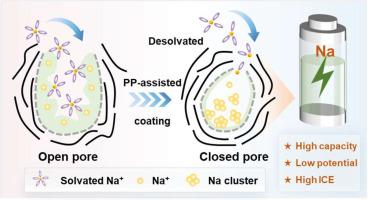高能量密度钠离子电池用硬炭闭孔结构与界面工程的协同调控
IF 20.2
1区 材料科学
Q1 CHEMISTRY, PHYSICAL
引用次数: 0
摘要
硬碳具有扩展的低电位平台容量,有望用于商用钠离子电池(sib)。然而,硬碳复杂的微观结构为合理设计活性位点以提高可逆钠存储能力而不影响初始哥伦比亚效率(ICE)带来了重大挑战。本文以废旧聚烯烃衍生活性炭(PC)为前驱体,成功制备了具有精细闭孔结构和可调孔入口的硬碳。孔隙结构的调节是通过调节聚丙烯基轻芳香族化合物沉积的碳层来实现的。最佳PP/PC-3电极在酯基电解质中具有393.5 mAh g−1的超高可逆容量和高达88.5%的ICE。而在基于醚的系统中,na存储容量达到477.3 mAh g−1,其中340.3 mAh g−1的容量来自低压平台区。阳极也表现出优异的低温兼容性以及卓越的循环稳定性。此外,组装的钠离子电池能量密度高达307.3 Wh kg−1,表明其在高能量密度sib中的应用前景广阔。此外,还阐明了Li/Na/K离子在封闭孔隙中存储过程的差异,为先进储能装置的碳阳极结构工程提供了深入的见解。本文章由计算机程序翻译,如有差异,请以英文原文为准。


Synergistic regulation of closed pore architecture and interface engineering in hard carbon for high energy density sodium-ion batteries
Hard carbon with extended low-potential plateau capacity holds promise for commercial sodium-ion batteries (SIBs). However, the complicated microstructure of hard carbon poses significant challenges in rationally designing active sites to improve reversible Na-storage capacity without compromising initial Coulombic efficiency (ICE). Herein, hard carbons with elaborate closed pore structures and tunable pore entrances were successfully fabricated using waste polyolefins-derived activated carbon (PC) as the precursor. The regulation of porosity architecture was realized by adjusting the deposited carbon layer derived from the polypropylene (PP)-based light aromatic compounds. The optimal PP/PC-3 electrode exhibited an ultra-high reversible capacity of 393.5 mAh g−1 and an ICE of up to 88.5% in the ester-based electrolytes. While in the ether-based systems, the Na-storage capacity reached 477.3 mAh g−1, with a capacity of 340.3 mAh g−1 stemming from the low-voltage plateau region. The anode also demonstrates excellent low-temperature compatibility as well as exceptional cycling stability. Additionally, the assembled sodium-ion full battery achieved an energy density as high as 307.3 Wh kg−1, suggesting its prospective application in high-energy-density SIBs. Furthermore, the differences in the Li/Na/K ion storage process within closed pores were elucidated, providing a deep insight into the structure engineering of carbon anode for advanced energy storage devices.
求助全文
通过发布文献求助,成功后即可免费获取论文全文。
去求助
来源期刊

Energy Storage Materials
Materials Science-General Materials Science
CiteScore
33.00
自引率
5.90%
发文量
652
审稿时长
27 days
期刊介绍:
Energy Storage Materials is a global interdisciplinary journal dedicated to sharing scientific and technological advancements in materials and devices for advanced energy storage and related energy conversion, such as in metal-O2 batteries. The journal features comprehensive research articles, including full papers and short communications, as well as authoritative feature articles and reviews by leading experts in the field.
Energy Storage Materials covers a wide range of topics, including the synthesis, fabrication, structure, properties, performance, and technological applications of energy storage materials. Additionally, the journal explores strategies, policies, and developments in the field of energy storage materials and devices for sustainable energy.
Published papers are selected based on their scientific and technological significance, their ability to provide valuable new knowledge, and their relevance to the international research community.
 求助内容:
求助内容: 应助结果提醒方式:
应助结果提醒方式:


